by Liza Dale-Hallett and Matthew Higgins
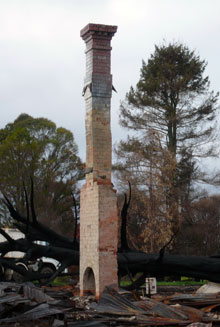
The chimney has now been installed in the Forest Gallery at Melbourne Museum.
Museum Victoria
Rescue collecting was the first priority. The collection began in the days following Black Saturday with donations from people who had lost their homes to the fires: a melted coin collection, household objects transformed by the fire (slumped glass, bent golf clubs, melted alloy wheels, the twisted remains of a child's bike). The other priority areas were tourist brochures representing the areas of Kinglake and Marysville before the fires and the most recent Country Fire Authority educational materials. One of the more challenging items to be rescued was a 7-metre-high chimney from a property in Kinglake. This has been re-erected at Melbourne Museum (part of Museum Victoria) to commemorate Black Saturday and to create a place to reflect on the historic and ongoing presence of bushfires across the Victorian landscape.
Following Museum Victoria's initial rescue collecting, further development of the collection has been strongly influenced by evolving community needs and partnerships. The Healesville Primary School has worked closely with Museum Victoria to exhibit over 40 works of art by students from grades 2 to 6. These artworks offer visitors a very powerful and personal insight into the experience of living with the daily realities of bushfire. Most of the children knew people who had lost property, homes or friends to the fires, some had lost their own home, and everyone had been through the trauma of evacuation multiple times. The inclusion of these works in the collection captures the experience of children, their families and the broader Healesville community, and demonstrates the role of art in the process of making meaning and contributing to community healing.
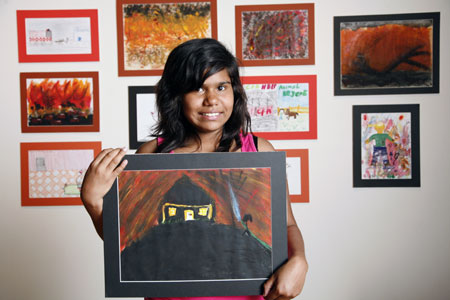
Netty's painting is exhibited at Melbourne Museum with 40 other bushfire works by students from Healesville Primary School.
photograph by David Loram
Museum Victoria
Museum Victoria is collaborating with the National Museum of Australia to develop mutually reinforcing collections. One of the National Museum's major themes is people's relationship with the Australian environment. Bushfire is a key element in the Old New Land gallery, portrayed in the 'Firetracks' display, which was initially developed for the Museum's opening in 2001. The National Museum continues to build on the fire theme, having recently acquired a truck from a New South Wales volunteer brigade, complete with all firefighting equipment. Just as rolls of honour have to be extended to accommodate the names of those who die in recent wars, 'Firetracks' was adapted during 2009 to make reference to the Black Saturday fires and the lives lost. Although Museum Victoria leads the Black Saturday collecting program, the National Museum will acquire some of the material collected by Museum Victoria, and will continue to collect some of its own. Part of one of these latter collections was displayed in the National Museum's hall to commemorate Black Saturday's first anniversary in February 2010. The National Museum plans to redevelop the Old New Land gallery over the next few years and it is likely that bushfire will be a major theme. This refurbishment will offer the potential for ongoing display of Black Saturday material.[1]
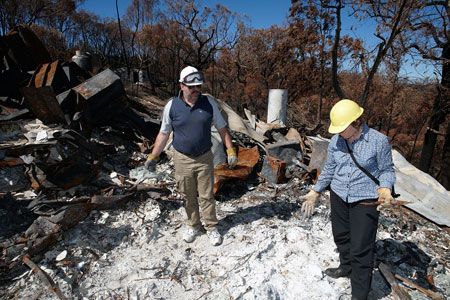
Bill donated many artefacts from the ruins of his home, including a bag of the fine white ash seen in this image, previously his tax files.
Museum Victoria
- The healing power of stories: For many, sharing stories has been part of the process of healing and coming to terms with the major change the bushfires has wrought on their lives. All of those involved in the Victorian Bushfires oral history program were motivated by the desire to help others avoid the trauma and loss they had suffered. By sharing their stories they wanted people to remember and learn from their own lived experience of fire.
- Acknowledging people's experiences and affirming people's lives: With the vast geographic spread of the bushfires (over 100 locations across Victoria), it is not surprising that some communities have felt a sense of being forgotten or neglected. One outcome of the collecting project has been to affirm the lives and experience of those located in areas that did not attract media attention.
- A place to reflect and commemorate: The first item from the collection to be displayed is the chimney rescued from Kinglake. The aim of this installation is to use this strong iconic symbol to offer a place for reflection and commemoration in Melbourne Museum's Forest Gallery.
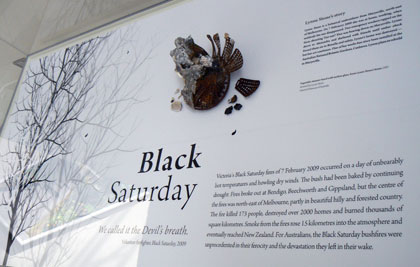
The featured object is a burnt vegetable steamer fused with molten glass, from the destroyed home of Marysville resident Lynne Stone.
National Museum of Australia
-
Contributing to the rebuilding of a sense of identity and place: The project will assist in the recovery process through rebuilding histories that were devastated by the bushfires. The collection will be available for loan and use as a historical resource for local museums and communities seeking to recreate their collective history and a sense of place.
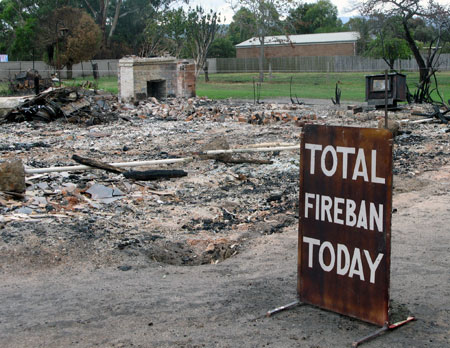
This sign was first created after the devastating Ash Wednesday bushfires in 1983, was burnt during the Devon North bushfire on Black Saturday, and was still in use in March 2009.
Museum Victoria
-
The importance of remembering: History shows that bushfires are a natural and essential feature of our ecosystem. The fire-dependent eucalypt forests of Victoria, together with drier and more extreme weather conditions, make this the most fire-prone place on earth. Museums can play an important role in helping the community remember and understand this — and show how history can be a tool in preparing for the next fire season.
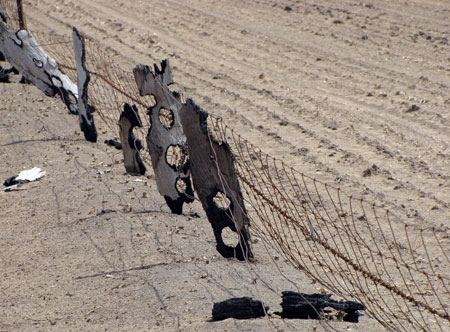
A collection of these posts was acquired for the bushfire collections of Museum Victoria and the National Museum of Australia.
Museum Victoria
- Connecting people through symbols: Another interesting facet of the emerging collection is its strong symbolic power. Ordinary items have assumed a new meaning and have become tangible examples of the fragility of life, the depth of loss, the miracle of survival, the ferocity of the fires, the challenges of living through extreme change, and the remarkable resilience of the human spirit. Melbourne Museum has exhibited a range of items with symbolic value: artwork from Healesville Primary School, the Black Saturday chimney and Sam the Koala. These symbols offer a depth of meaning and emotional resonance that can assist in bridging the social disconnection and dislocation that resulted from the bushfires and facilitate connections between people.
Bushfire has been a characteristic of the Australian continent for millions of years. It has been a feature of human experience of this land for 60,000 years. Museum collections and exhibitions play a significant role in representing bushfire to Australians and others. The Victorian Bushfires Collection offers deep insights into one of the most traumatic elements of our relationship to our environment. As concerns about global warming increase and the threat of catastrophic bushfire rises, the collection is destined to play an important part in the national consciousness.
